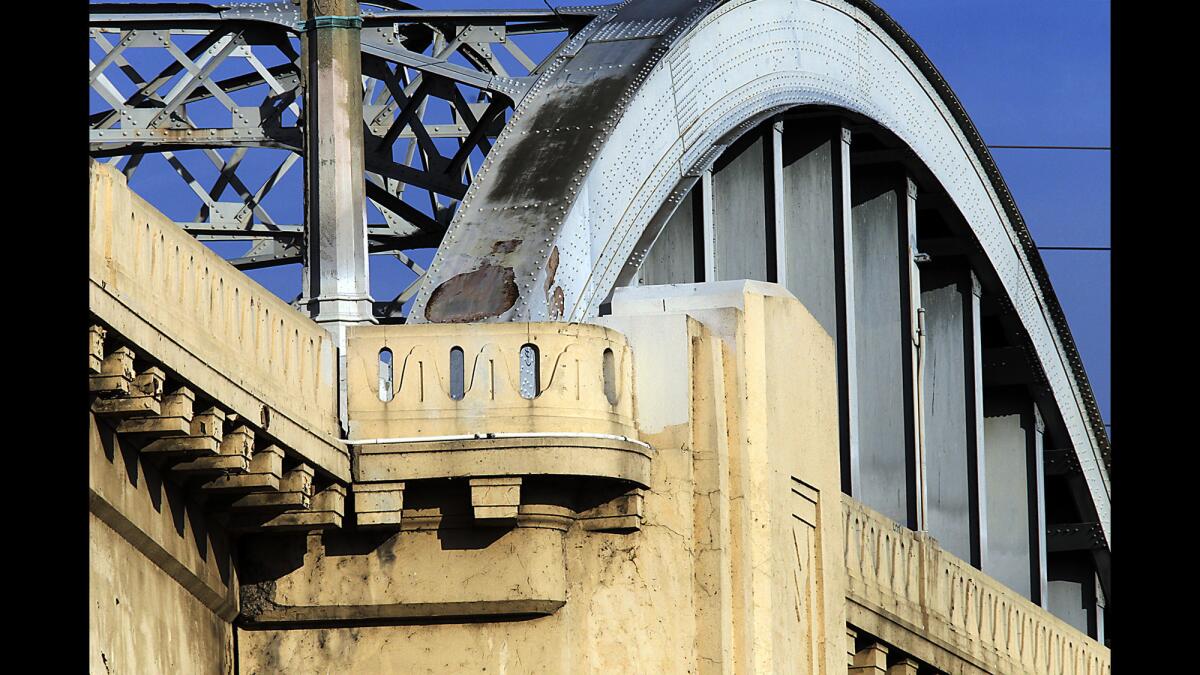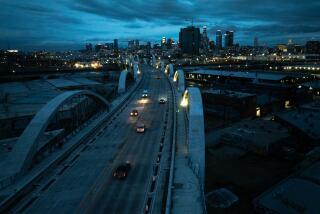6th Street Bridge, a dying landmark, honored with art show in its last days

Demolition on the old span begins this summer. The city is making intersection improvements to improve traffic flow in the Arts District and in Boyle Heights for the 13,000 daily drivers who will no longer be able to take this route.
- Share via
Too often, tributes to Los Angeles history come too late — when the guests of honor are long gone.
Old structures in this city disappear so fast, to say farewell we stand where they used to stand and stare into the voids.
The 6th Street Viaduct, however, is having a long goodbye.
The 83-year-old bridge’s days have been numbered for years.
In 2007, the city historic-cultural monument was diagnosed with a terminal case of “concrete cancer” — alkali silica reaction, which caused it to crack and deteriorate and become too great a seismic risk.
In 2012, an international design competition was held for its replacement. A winner was chosen, called “The Ribbon of Light”: modern, undulating, sleek and pedestrian- and bike-friendly, with green spaces and steps to climb for sweeping views of the surroundings.
Now demolition on the steel-arched span that connects Boyle Heights to downtown is due to start by the end of the year. And one of its neighbors in the Arts District, Art Share L.A., is giving it a wake.
The nonprofit creative art center has staged an exhibit called “Ode to the Bridge.” It features 78 works by local artists who were asked to “honor this historic and beloved landmark that has graced our skyline for decades.”
Even though its destruction has been looming, many Angelenos may be unaware. Dale Youngman, a curator of the show, said she first learned about the $420-million bridge replacement project about six months ago.
“I love the bridge. I travel over it frequently. I wanted to do something to commemorate it,” she said.
Youngman’s co-curator is city urban planner Tanner Blackman. They brought in architectural historian Andrea Galvin, who is documenting river bridges for the city, to provide historical context.
That the first call for exhibit submissions came a few months before the show’s opening wasn’t a big problem. Many of the artists who came forward already had plenty of bridge artwork to choose from. The structure, they said, has been inspiring them for years.
They’ve found ways to explore it — sneaking below it where the river cuts through, even driving their cars onto the river channel when there was very little water.
Some paint it. Some photograph it. Some like the long views, showing other river bridges, like skipping stones, in the distance.
Some prefer to zoom in. One artist in the show, Carol Cirillo Stanley, focused on rivets and rust in two photographs reproduced on metal. Others were drawn by the graffiti the bridge always attracts.
At the show’s recent opening, people paused outside the main gallery to watch a video of the street artist who calls himself Wild Life, rapidly painting a ship called the USS Wild Life on a pylon in the river.
Several hundred sipped wine and beer and looked at image after image of the bridge — abstract, surreal, being walked on by a cow and being chomped by a shark in a baseball cap.
The 6th Street Viaduct is the city’s longest river bridge, stretching 3,546 feet over industrial lots, the Los Angeles River and railroad tracks on both sides. Its pair of asymmetrical steel arches, each spanning 150 feet, are familiar images even to those who have never visited the city because they have appeared in so many advertisements, TV shows, videos and movies.
They’re familiar to artist Jim Stern because he’s lived alongside them for a decade — and walked the old bridge more times than he can count.
He’s 89, and the years have bent him. He walks with a cane and says that on more than one occasion, he’s been stopped on the bridge by someone looking worried and warning him to be careful of the cracks.
The show, which closes Saturday night, features four of Stern’s watercolors — including images of the shuttle Endeavour flying above it, a woman walking her dog alongside it and a crew cleaning the graffiti on the banks of the concrete channel beneath it.
He called the old bridge “inspiring” but said he was excited too for the new one — which will feature 10 pairs of spans at varying heights that rise and fall and splay outward. “That’ll be breathtaking,” he said. “Very exciting.”
Cheyanne Sauter, Art Share L.A.’s executive director, was similarly optimistic.
“Since I’ve been working downtown, I have seen so much change and gentrification and people getting angry and homeless being squeezed out and homeless being invited back in and the ebb and flow,” she said. “I think transition is hard, but change often is good.”
Cities, after all, are built layer upon layer.
Art Share L.A. is on the site of what in the early 1900s was a residence. In the 1920s, it became a textile recycling center. Then in the 1980s, the old warehouse space found itself in an area attracting more and more artists.
Rents went up and, as artists were being priced out, Art Share L.A. arrived in 1997 — converting the top floor of the old rag shop into 30 small but affordable live/work lofts to help some artists stay put. The center offers creative work spaces, including a ceramics studio. It supports itself in part by renting space to all sorts of groups in the increasingly chic area.
Change happens. You try to adjust. Sometimes there is nothing you can do except perhaps to pause and try to properly appreciate the before that the after will oust.
Follow City Beat @latimescitybeat on Twitter and at Los Angeles Times City Beat on Facebook.
More to Read
Sign up for Essential California
The most important California stories and recommendations in your inbox every morning.
You may occasionally receive promotional content from the Los Angeles Times.











